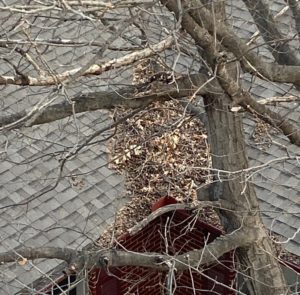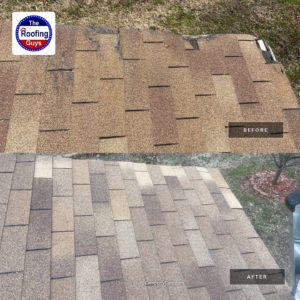If you are a DIY homeowner, you want to take good care of your roof so it’ll take good care of you. Proper roof maintenance gives your roof a longer life while helping you avoid damaging leaks that can cost a lot in repairs. You may wonder what type of roof maintenance you canto do to stay on top of your duties. We’ve got you covered. Here’s a guide for beginners looking to DIY roof maintenance.
1. Keep an Eye Out for Debris—Your Roof’s Enemy
Don’t allow debris to sit on top of your roof. Branches, leaves, and other debris that accumulate on your roof invite mold, moss, and moisture that can prematurely age your roof. Debris on your roof can retain water and allow water to get under your roof shingles and cause destructive rot to your roof decking and throughout your home.

There are some tips to know about debris clearing. First, you should never do it alone. Always have a spotter when you climb up on your roof to clear away debris. An extendable ladder is helpful to safely access the top of your roof. Make sure you have a way to attach the ladder to the roof or gutters so that it does not get knocked over and leave you stranded.
It’s also smart to do roof maintenance on clear, sunny days when your roof is dry. This will help prevent slips and improve visibility.
Take the opportunity to look for damage while you’re up on your roof clearing debris. Of course, you should never force yourself to go up on your roof if you feel unwell, unsteady, or unprepared. There are plenty of roofing companies in Tulsa that can handle seasonal roof care and inspections.
2. Find Red Flags and Nip them in the Bud
A seasonal roof cleaning creates a perfect opportunity for a general inspection and repairs. You just have to know what to look for while you’re up there.
The first part of roof inspection starts inside your home. First, check the ceiling & the attic for any stains that may indicate water leakage caused by a roof issue. Have you noticed any stains on the ceilings in your home? Make note of where they’re located because they could actually be roof leaks.
Here’s a checklist for what to look for on your roof:
- Missing shingles
- Loose shingles
- Lifted shingles
- Signs of moss or mold
- Worn spots
- Cracking, peeling, or curling shingles
- Loose flashing
- Loose nails
Be sure to replace loose shingles, flashing, or hardware as soon as you notice the issue to prevent damage. Shingles that are displaced could have water damage to the roof decking beneath your shingles. This will require an intervention.
If you see excessive peeling, curling, cracking and lifted in shingles throughout your roof, it’s possible that your roof has simply reached the end of its lifespan. It may be time to bring in a local roofing company to confirm if it’s time to move on from trying to extend the lifespan of your roof to picking out a new roofing option.
When you see excessive debris, consider if it’s time to rethink your landscaping plans. Tall trees located near your roof could be giving leaves, twigs, and small animals a direct pathway to your roof. Shade allows mold and moss to grow.
Did You Find Any Moss or Mold on Your Roof?
If your see moss or mold growth on your roof, it’s important to address the issue. Consider using moss or mold remover on the growth areas to gently brush the matter away using a bristled broom or handheld brush.
Avoid power washers or hard-bristle brushes because they can actually wipe away the UV coating that protects your shingles. You can also bring in a roofing expert to help you safely get rid of moss or mold on your roof.
3. Trees and Shrubs: Keep ALL limbs and shrubs trimmed away from the roof.
Tree limbs or shrubs are a problem if they are touching, or close to your roofs’ surface or edge. Though they may seem harmless, they can cause damage to your roof during a storm. Wind can cause the limbs & shrubs to rub against the shingles causing premature wear and damage to the shingles. Tree limbs and shrubs need to be trimmed back several feet from your shingles.

4. Beyond Shingles: Don’t Ignore Soffits, Fascia, Gutters, and Downspouts
All of these components of your roof should be included in any plan for roof maintenance. First, make sure you’re scooping debris from gutters and downspouts when you do your general debris removal from your roof.
Use a soft-bristle brush to wipe away any dirt or grime discovered on your gutters and downspouts. You can also wash out the gutters with your garden hose.
Inspect for any missing caulk, peeling paint, cracks, holes, or signs of rotting. Look for any missing sections of gutter or gutter screens that need to be replaced. Missing or broken gutter hardware can also lead to leaks. Make all replacements and repairs immediately.
Always be conscious of your body’s positioning while you’re inspecting or cleaning roof components. Leaning against your gutters while cleaning can actually damage gutters. It is also an easy way to fall off your ladder.
Consider Gutter Screens
If your gutters are filled with debris, consider installing gutter screens or covers that will drastically shorten the amount of time you need to spend cleaning out your gutters seasonably. Even if you have gutter screens, it is a good idea to do an annual cleaning by using a garden hose to wash out the gutters.
5. Look at Chimneys, Skylights, and Vent Openings
Once your main roof sections have been looked at, it’s time to move on to large accessories.
You should inspect a rock or brick chimney for cracked bricks, missing bricks, cracked mortar, and any other signs of irregularity.
If your chimney has siding, you should check the condition of the paint. If the paint is old, it may be time for a new coat of paint. When the siding has not been painted regularly, the paint can wear thin and allow water into the siding, causing rot. When the siding and trim are rotted, they need to be replaced and painted. Rotted siding will not hold paint adequately to protect against further damage and/or leaks.
A chimney with siding will have a metal Chimney Cap. You should inspect the chimney cap for rust. If the rust isn’t too deep, you can clean with it with a wire brush and then spray a rust converter on the affected area. When the rust is too deep or extensive, or if the rust has caused holed, then you need to replace the chimney cap. It is best to have a licensed roofing company replace the chimney cap.
Chimneys should be sealed with water-repellent products regularly. A DIY homeowner can seal their brick and stone chimneys with Thompson’s Water Sealer. The Roofing Guys offer a service to seal brick or stone chimneys with a sealant approved by the Department of Transportation for use on concrete roads and highways.
Finally, do a roundup of all vent outlets and skylights. You want to look for any signs of damaged or lifted flashing, and any signs of cracked or damaged silicone around pipe boots. Any pipe boots with cracked or broken silicone should be replaced.
IF YOU HAVE A LEAK
If you are a DIYer and have a roof leak read our article Roof Leaks Tulsa.
